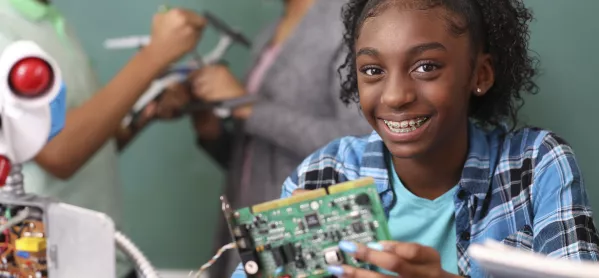- Home
- 4 ways to get more black students in Stem
4 ways to get more black students in Stem

I studied chemistry at university. My cohort was large, as to be expected of such a broad and straightforward discipline. But of this large cohort, I was the only black female.
I remember realising this fact when I turned up for our first modules and I sat looking around the room - when you are the only one, particularly as a black person, you cannot help but notice.
“You don’t look like the usual ‘type’ to study chemistry,” someone commented. And looking at the numbers, they weren’t wrong.
Lack of diversity in Stem
I was one of just three black students on the chemistry course, out of around 60 students, and this meant we made up around 5 per cent of the total.
Overall, the number of undergraduates in science, technology, engineering and maths (Stem) subjects is still disproportionately low and, like many countries, the UK faces a shortage in people well equipped with the skills needed to become part of the Stem workforce.
Making the change
As an educator, our role in educating our young people on the importance of Stem fields is pivotal. Many of our students do not realise how vast and wide Stem really is and just see it as “sciencey stuff” or “working with computers”.
They do not understand how the skills they learn in many of the Stem subjects stretch beyond “pipette technique” or “drawing graphs” (although, we know how much they love drawing a graph).
Stem encompasses a spectrum of skills and vocations, such as concrete engineering, or music engineering, design, animation, academic research, cosmetology...and, some might argue most importantly, teaching.
Diversity matters
There are black successful Stem graduates and professionals out there and it is up to us to find them and showcase them. I started Young Gifted and Stem for this very reason - to showcase Stem role models and provide students with great opportunities for engagement with these subjects.
So, how else can we as teachers, particularly teachers of Stem, provide our students with more inspiration and interest in our subjects, beyond compulsory education?
Here are some of my suggestions for teachers looking to do the same.
1. Organise a Stem Fair
My science department holds an annual Stem fair, which allows teachers and a range of external volunteers to showcase their respective fields in Stem.
We ask the IT, design technology and maths departments to contribute, and together we demonstrate Stem as a school.
Volunteers over the years have included civil engineers, biomedical scientists, robot programmers, astrophysicists, accountants from the “big four”, as well as teaching colleagues in FE and HE who work within their respective engineering departments.
By showing students how far-reaching Stem can be, we widen their expectations of what they can become.
2. Start outreach projects
Every school will have universities with whom they can collaborate on student projects. I would really recommend contacting them to ask them to partner with your school.
I have run several collaborative projects with universities, such as London South Bank and Kingston University; taken part in region-wide Stem competitions allowing our students to showcase their designs at London City Hall and we have had visitors come in and talk to the students about their careers in Stem.
For young black people, visual representation is so important, because it can be hard to be what you can’t see.
3. Promote teaching
Since I took part in the national “Get into Teaching” media campaign in 2017, students have increasingly realised that teaching is a career open to them, too.
“Miss, how much do teachers get paid?” (A question I’m sure every teacher has been asked!) “Miss how many years does it take to become a teacher?” “Miss, what do I need to study to become a teacher?”
These are all questions that I’ve been asked regularly. They understand that teaching is challenging, and that it can be stressful at times, but they also understand and observe how enjoyable and fulfilling teaching is, too.
I also make them aware how much potential teaching has for career growth - my career, particularly within my current school, has been a testament to that.
4. Outreach opportunities
Take up as many outreach opportunities with organisations and higher education institutions as you possibly can. The amount of science capital a student has cannot be capped, so why would we not take as many opportunities as we can to enrich the lives of our students, outside of the school walls?
Most, if not all, universities will offer outreach visits, programmes, experiences; it is literally written into policies of companies to ensure they are doing their bit to widen participation.
A good place to start is with the Royal Societies. The Royal Society of Biology, Chemistry, Astronomy, Institute of Physics, and Stem Learning are good starting points, as well as your local universities.
Genevieve Bent teaches science and is the head of science at Harris Invictus Academy Croydon; she founded Young Gifted and Stem in November 2019
Register with Tes and you can read two free articles every month plus you'll have access to our range of award-winning newsletters.
Keep reading with our special offer!
You’ve reached your limit of free articles this month.
- Unlimited access to all Tes magazine content
- Save your favourite articles and gift them to your colleagues
- Exclusive subscriber-only stories
- Over 200,000 archived articles
- Unlimited access to all Tes magazine content
- Save your favourite articles and gift them to your colleagues
- Exclusive subscriber-only stories
- Over 200,000 archived articles

